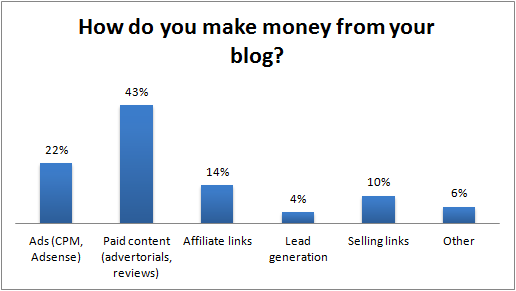 |
| Survey by Moz |
Pay Per Click, or PPC, is the most popular (and easy to do) monetization method, and Google Ads is the most popular platform. To use it, a webmaster needs to reserve areas of their website for ads. Then, Google places ultra-targeted ads in these areas, which are different for each viewer. Every time users click on these ads, the webmaster is paid. The profit per click depends on the keyword the ad targets, and the region where the user is located. Countries such as USA, Canada and Australia bring higher profits than India and China, for example. Usually, the profit per click is low, ranging from 0.01$ to $0.10; However, high-traffic keywords have been known to bring in $2 or more per click.
 |
| Google's PPC ads (outlined in red). Source: Online Income Lab |
PPC profit can easily be calculated, as the click-through rate of the ads is about 10%. That means, if a blog gets 1000 views daily, there will be about 100 click-throughs - and assuming the profit is $0.05 per click, the webmaster will earn $5.
Therefore, 1000 daily views can bring in $100 - $200 monthly via Google Ads.
Other similar methods include Pay Per Download (PPD) or Pay Per Install (PPI). In these cases, the webmaster provides a file which is "wrapped" in ads. When the user downloads or installs the file, they view the ads, and the webmaster gets paid for this. Such methods are popular in the so-called "black hat" community, with illegal game, software or film download sites.
Promotional articles and paid links are also a way to profit from a high-traffic blog. Advertisers and brands offer bloggers payment for posts that promote the brand or one of its products. Not all bloggers are willing to this, as such a post might not truly reflect the blogger's opinions and thoughts.
 |
| Survey by Moz. |
Companies can also pay bloggers for simply inserting a specific link, without the need to dedicate an entire post to it. This is done only for SEO and the purpose of acuiring "link juice." As with promotional articles, not all bloggers will do this.
High-traffic bloggers say they receive more than 10 such offers a day, which suggests this can provide a good source of side income.
Affiliate Marketing is another way to monetise a blog. In this case, the webmaster profits when a user buys a product through a specific link.
 |
| A VigLink dashboard showing affiliated clicks and earnings |
There are many affiliate marketing programs and services. One good example is VigLink. They work with a great number of online merchants and retailers, such as eBay, Amazon, Etsy, etc. A VigLink affiliate can market any product sold on these websites, as long as they use a special link to that product. When users enter the product page through the affiliate link and purchase the product, the affiliate (who provided the link) gets a commission of the sale.
Becoming an affiliate is as easy as filling out a sign-up form. Afterwards, affiliate links can be created by inserting a regular link to a purchase page into Viglink's webform, which then returns an affiliate link to the same page. This link is then copy-pasted into content. Viglink also has an automated feature, which scans through content and adds links automatically by recognizing product and brand names. However, this feature has been tested and proven not as efficient - not all product names are recognized, and links scattered throughout content can be overwhelming to readers.
Skimlinks is a very similar program that works in exactly the same way. Publishers, however, seem to prefer VigLink.
There are many other affiliate programs. Google Affiliate Network, for example, is a reliable one. It is not automated like VigLink - publishers are require to manually look up relevant products and insert the links into their content. Other similar networks include LinkShare, Commission Junction and Pepper Jam.
Some networks are specialized in a niche - fashion seems to be a popular one, as it is very lucrative. The main such networks are Reward Style and Fashion Traffic. Many brands and companies also offer their own affiliate programs, where the company has to be contacted directly, instead of filling out a simple sign-up form.
Clickbank is another affiliate network which sells only digital products and is focused on one-man businesses rather than big corporations. Anyone can submit a product to Clickbank - an e-book, an online course, stock photography, design resources. Then, they provide the platform to sell it, and the affiliates to market it.
The product has to be accompanied by two webpages: a landing page with a "purchase" button (which takes the customer to Clickbank's purchase page) and a "Thank You" page where the user is redirected after completing the purchase. In simple words, the seller only needs to provide the product and the webpages, and the affiliates do the rest of the work.
To give affiliates an incentive for this, Clickbank provides extremely high commissions - up to 75%. For this reason, the website is also used by black hat marketers in get-rich-quick SEO schemes. Nevertheless, when used legitimately, it can still provide a source of side-income for bloggers and webmasters.
Finally, a blog or website can be monetized by selling the blogger/webmaster's own products or services. This can include linking and promoting an eBay or Etsy shop (or any other online shop). Offering services (such as web design) is also an option. In this case, the traffic is not exactly being monetized - the profit comes from the products/services and not the traffic itself. However, it greatly enhances the promotion of these products.